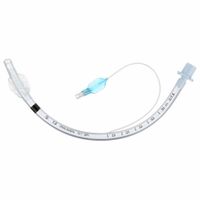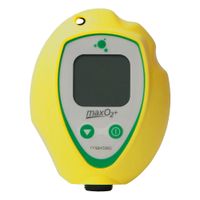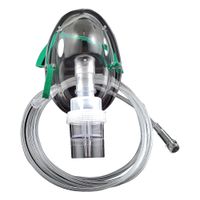Call +(254) 703 030 000 / 751 483 999 / 721 704 777
- Home
- Safety
- Medical Supplies Equipment
- Airway Opening Oxygen Delivery Equipment
.....Read More
Frequently Asked Questions
What is the purpose of intubation in respiratory distress?
Intubation in respiratory distress serves several critical purposes. Primarily, it ensures the maintenance of a patent airway, which is essential when a patient is unable to breathe adequately on their own due to obstruction, injury, or severe illness. By inserting an endotracheal tube into the trachea, healthcare providers can secure the airway, preventing aspiration of gastric contents, blood, or other substances that could lead to further complications like pneumonia.
Additionally, intubation facilitates mechanical ventilation, which is crucial for patients experiencing respiratory failure. Mechanical ventilation supports or replaces spontaneous breathing by delivering oxygen directly to the lungs and removing carbon dioxide, thereby correcting hypoxemia (low blood oxygen) and hypercapnia (elevated blood carbon dioxide levels). This is particularly important in conditions such as acute respiratory distress syndrome (ARDS), chronic obstructive pulmonary disease (COPD) exacerbations, or severe asthma attacks, where the patient's respiratory muscles are fatigued or overwhelmed.
Intubation also allows for the administration of high concentrations of oxygen and the delivery of medications directly into the lungs if necessary. It provides a route for suctioning secretions, which can accumulate and obstruct the airway, further compromising respiratory function.
Moreover, intubation is a critical step in advanced life support during cardiopulmonary resuscitation (CPR), ensuring that effective ventilation is maintained while chest compressions are performed. It also stabilizes the airway in trauma patients with potential cervical spine injuries, where neck movement must be minimized.
In summary, intubation in respiratory distress is a life-saving intervention that secures the airway, facilitates ventilation, prevents aspiration, and allows for effective management of respiratory failure, ultimately stabilizing the patient's condition and improving their chances of recovery.
How does suction equipment help in clearing airways?
Suction equipment is vital in clearing airways by removing obstructions such as mucus, blood, saliva, or vomit, which can impede breathing. This equipment creates a vacuum that draws out these secretions, ensuring the airway remains open and clear.
The process begins with the insertion of a suction catheter into the airway, either through the mouth, nose, or tracheostomy tube. The vacuum generated by the suction device pulls the secretions into a collection container, preventing them from being aspirated into the lungs, which could lead to infections like pneumonia.
Suctioning is particularly crucial for patients who cannot clear their airways independently due to conditions like neurological impairments, unconsciousness, or post-surgical recovery. It helps maintain adequate oxygenation and ventilation by ensuring that the airway is free from blockages.
Moreover, suction equipment is essential in emergency situations, such as during cardiac arrest or respiratory distress, where rapid airway clearance can be life-saving. It is also used in routine care for patients with chronic conditions that produce excessive secretions, such as cystic fibrosis or chronic obstructive pulmonary disease (COPD).
In summary, suction equipment plays a critical role in airway management by effectively removing obstructions, thereby facilitating proper breathing and reducing the risk of respiratory complications.
What are the benefits of using medical oxygen for breathing difficulties?
Medical oxygen provides several benefits for individuals experiencing breathing difficulties. It increases the amount of oxygen available in the bloodstream, which is crucial for patients with conditions like chronic obstructive pulmonary disease (COPD), pneumonia, asthma, and heart failure. By enhancing oxygen levels, it helps alleviate symptoms such as shortness of breath, fatigue, and confusion, improving overall quality of life.
Oxygen therapy can also reduce the strain on the heart by ensuring that tissues and organs receive adequate oxygen, thereby preventing complications associated with hypoxemia (low blood oxygen levels). This can lead to improved exercise tolerance, allowing patients to engage in physical activities with less discomfort and more endurance.
For patients with acute respiratory distress, medical oxygen can be life-saving, stabilizing their condition until further medical treatment is administered. It also plays a critical role in surgical settings and emergency care, ensuring that patients maintain adequate oxygenation during procedures and recovery.
In chronic conditions, long-term oxygen therapy has been shown to increase survival rates and decrease hospital admissions. It can also improve sleep quality for those with sleep apnea or other nocturnal breathing disorders by maintaining oxygen levels throughout the night.
Overall, medical oxygen is a vital component in the management of respiratory conditions, providing symptomatic relief, enhancing physical capabilities, and improving overall health outcomes.
How is medical gas delivery equipment used in hospitals?
Medical gas delivery equipment is essential in hospitals for providing life-sustaining gases to patients. These systems deliver gases like oxygen, nitrous oxide, medical air, and carbon dioxide, each serving specific medical purposes.
Oxygen delivery systems are crucial for patients with respiratory issues, ensuring they receive adequate oxygen levels. Equipment such as oxygen concentrators, cylinders, and wall outlets connected to a central supply system are used to administer oxygen through masks, nasal cannulas, or ventilators.
Nitrous oxide is commonly used in anesthesia to sedate patients during surgical procedures. It is delivered through anesthesia machines that mix it with oxygen, ensuring safe administration.
Medical air, a clean supply of compressed air, is used in respiratory treatments and to drive ventilators. It is delivered through pipelines connected to wall outlets, ensuring a consistent and sterile supply.
Carbon dioxide is used in specific surgical procedures, such as insufflation during laparoscopic surgeries, to inflate body cavities for better visibility and access.
The delivery systems include a network of pipelines, valves, and outlets that distribute these gases from a central supply source, such as bulk tanks or cylinders, to various hospital areas. Pressure regulators and flow meters ensure the correct pressure and flow rate, while alarms and monitoring systems maintain safety by detecting leaks or pressure drops.
Regular maintenance and strict adherence to safety protocols are vital to prevent contamination and ensure the reliability of these systems. Proper training for healthcare staff on the use and management of medical gas equipment is also essential to ensure patient safety and effective treatment.
What is the difference between a nebulizer and a steam inhaler?
A nebulizer and a steam inhaler are both devices used to deliver medication or moisture to the respiratory system, but they operate differently and serve distinct purposes.
A nebulizer is a medical device that converts liquid medication into a fine mist or aerosol, which can be inhaled directly into the lungs. It is commonly used for patients with respiratory conditions such as asthma, COPD, or cystic fibrosis. Nebulizers are particularly beneficial for delivering bronchodilators, corticosteroids, or other medications that need to reach the lower airways. They are powered by electricity or batteries and typically consist of a compressor, a nebulizer cup, and a mouthpiece or mask. The mist produced is cool, and the device is suitable for both children and adults.
In contrast, a steam inhaler, also known as a vaporizer, is a device that heats water to produce steam, which is then inhaled. It is primarily used for relieving symptoms of colds, sinusitis, or nasal congestion by moisturizing the nasal passages and throat. Steam inhalers do not deliver medication but can be used with essential oils or other natural remedies for added therapeutic effects. The steam is warm, providing soothing relief for irritated airways. Steam inhalers are generally simpler and more portable than nebulizers, often consisting of a water reservoir and a mask or nozzle.
In summary, the key difference lies in their function: nebulizers deliver medication directly to the lungs, while steam inhalers provide moisture and warmth to the upper respiratory tract. Nebulizers are used for specific medical treatments, whereas steam inhalers are used for symptomatic relief.
How do you properly use a respiratory nebulizer?
1. **Preparation**: Wash your hands thoroughly with soap and water. Gather all necessary equipment: the nebulizer machine, medication, mouthpiece or mask, and tubing.
2. **Assemble the Nebulizer**: Connect the tubing to the nebulizer machine. Attach the other end of the tubing to the nebulizer cup. Ensure all connections are secure.
3. **Add Medication**: Open the nebulizer cup and add the prescribed medication. Use a dropper or pre-measured vial if provided. If instructed, dilute the medication with saline solution. Close the nebulizer cup tightly.
4. **Attach Mouthpiece or Mask**: Connect the mouthpiece or mask to the top of the nebulizer cup. Choose a mouthpiece for adults and older children, or a mask for younger children or those unable to use a mouthpiece.
5. **Positioning**: Sit in an upright, comfortable position. If using a mask, ensure it fits snugly over the nose and mouth. If using a mouthpiece, place it between your teeth and close your lips around it.
6. **Start the Nebulizer**: Turn on the nebulizer machine. You should see a mist coming from the mouthpiece or mask. Breathe in slowly and deeply through your mouth, holding each breath for a few seconds before exhaling.
7. **Duration**: Continue the treatment until the medication is gone and the nebulizer stops producing mist, usually 10-15 minutes.
8. **Post-Treatment**: Turn off the machine. Rinse your mouth with water if using a steroid medication. Clean the nebulizer parts according to the manufacturer's instructions, typically by washing with warm, soapy water and air drying.
9. **Storage**: Store the nebulizer parts in a clean, dry place until the next use. Regularly check and replace any worn or damaged parts.
What safety precautions should be taken when using oxygen delivery equipment?
When using oxygen delivery equipment, several safety precautions are essential to prevent accidents and ensure effective treatment:
1. **No Smoking or Open Flames**: Oxygen supports combustion, so keep the area free from smoking, open flames, and flammable materials.
2. **Proper Ventilation**: Ensure the room is well-ventilated to prevent oxygen accumulation, which can increase fire risk.
3. **Secure Equipment**: Firmly secure oxygen tanks to prevent them from falling and potentially causing injury or damage.
4. **Avoid Oil and Grease**: Keep oil, grease, and petroleum-based products away from oxygen equipment, as they can ignite easily in an oxygen-rich environment.
5. **Check for Leaks**: Regularly inspect equipment for leaks or damage. Use soapy water to check for leaks around connections.
6. **Use Correct Equipment**: Only use equipment specifically designed for oxygen delivery. Ensure all components are compatible and in good condition.
7. **Proper Storage**: Store oxygen tanks upright in a cool, dry place away from heat sources. Use a cart or stand designed for oxygen tanks.
8. **Training and Instructions**: Ensure all users are trained in the correct use of the equipment and understand emergency procedures.
9. **Electrical Safety**: Keep electrical appliances and cords away from oxygen equipment to prevent sparks.
10. **Labeling**: Clearly label oxygen equipment and storage areas to alert others of the presence of oxygen.
11. **Emergency Preparedness**: Have a fire extinguisher nearby and ensure everyone knows how to use it. Know the emergency contact numbers.
12. **Regular Maintenance**: Schedule regular maintenance and inspections by qualified personnel to ensure equipment is functioning correctly.
By following these precautions, the risks associated with oxygen delivery equipment can be minimized, ensuring safety for both the user and those around them.



